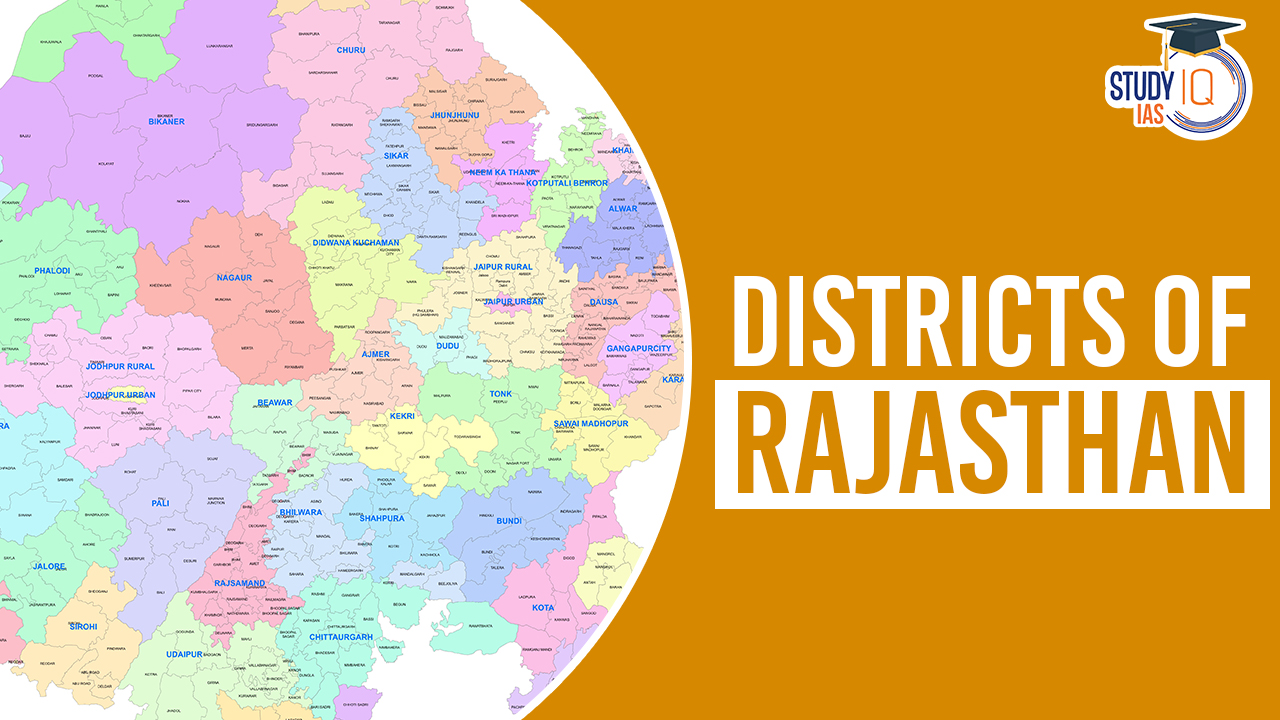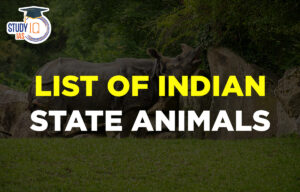Table of Contents
Districts of Rajasthan
Rajasthan is a state in India known for its rich history, culture, and heritage. It is divided into 33 districts, each with its own unique identity and significance. The districts are spread across the state and showcase the diversity of Rajasthan’s geography, from the arid Thar Desert in the west to the hilly terrain in the east. The districts are home to various communities and are known for their distinct cuisines, handicrafts, and festivals. The state government has established several initiatives to promote tourism and development in these districts, showcasing their historical and cultural significance.
Read More: Districts of Haryana
List of Districts of Rajasthan
| S. No | District | Importance |
| 1 | Ajmer | Ajmer is an important religious and cultural center, famous for the Ajmer Sharif Dargah, the tomb of Sufi saint Khwaja Moinuddin Chishti, which attracts many devotees from all over the world. |
| The city of Ajmer also has a number of historical and architectural attractions, such as the Taragarh Fort, Adhai Din Ka Jhonpra, and Ana Sagar Lake. | ||
| Ajmer is a significant educational hub, with many schools, colleges, and universities, including the prestigious Mayo College, one of the oldest public schools in India. | ||
| 2 | Alwar | Alwar is a historically and culturally rich city, known for its royal heritage and the magnificent palaces and forts built by the Rajputs, such as the Alwar Fort and the Bala Quila. |
| The city is surrounded by the Aravalli Range, which offers many opportunities for adventure tourism, such as trekking, hiking, and camping. | ||
| Alwar is also known for its wildlife sanctuaries and reserves, such as the Sariska Tiger Reserve, which is home to several species of animals and birds. | ||
| 3 | Banswara | Banswara, a district in southern Rajasthan, India, is known for its many islands and hills surrounded by the Mahi River, and is also called the “Cherrapunji of Rajasthan” due to its rainfall. |
| Banswara is a tribal-dominated district, known for its unique culture and traditions, such as the colorful and vibrant Bhagoria Festival, which celebrates love and courtship. | ||
| The district has a rich history and is home to several ancient temples and monuments, such as the Andeshwar Parshwanath Jain Temple and the Mahi Dam. | ||
| 4 | Baran | Baran is well-known for its unique carnival or festival called Dol Mela, which is celebrated for around 15 to 20 days after the festival of Dol Gyaras. |
| The district is home to several historical and cultural attractions, such as the ancient temples of Bhand Devra. | ||
| Baran is also an important agricultural hub, known for its production of wheat, maize, and soybean, and is home to several food processing units and agricultural research centers. | ||
| 5 | Barmer | Barmer is a district located in western Rajasthan, known for its unique culture and traditions, as well as its historical and architectural landmarks, such as the Barmer Fort and the Kiradu Temples. |
| The district is also known for its handicrafts, particularly its textiles, such as the famous Barmer embroidery, which is popular all over India and abroad. | ||
| Barmer is home to several natural and man-made attractions, such as the Sand Dunes of Khuri and the Badlands of Barmer, which attract a large number of tourists every year. | ||
| 6 | Bharatpur | Bharatpur is a district located in eastern Rajasthan, known for its rich history and architectural heritage, particularly its famous bird sanctuary, Keoladeo National Park, which is a UNESCO World Heritage Site. |
| The district is home to several ancient forts and palaces, such as the Lohagarh Fort, Deeg Palace, and the Bharatpur Palace, which are popular tourist destinations. | ||
| Bharatpur is also an important agricultural and industrial center, known for its production of crops such as wheat, mustard, and bajra, as well as industries such as textiles, chemicals, and metalworking. | ||
| 7 | Bhilwara | Bhilwara is a district located in southern Rajasthan, known for its textile industry, particularly the production of high-quality fabrics such as cotton and silk. |
| The district is also known for its unique culture and traditions, as well as its historical and architectural landmarks, such as the Harni Mahadev Temple and the Badnore Fort. | ||
| Bhilwara is an important educational hub, with several colleges and universities, including the MLV Textile and Engineering college. | ||
| 8 | Bikaner | Bikaner is a district located in northwestern Rajasthan, known for its rich history and architectural heritage, particularly its famous Junagarh Fort, which is an important tourist attraction. |
| The district is also known for its unique culture and traditions, as well as its food, including famous snacks like Bikaneri Bhujia and sweets like Rasgulla and Ghevar. | ||
| Bikaner is an important center for trade and commerce, with several industries such as ceramics, wool, leather, and chemicals, as well as a large number of small-scale businesses and shops. | ||
| 9 | Bundi | Bundi is a district located in southeastern Rajasthan, known for its unique architecture and historical landmarks, such as the Bundi Palace, Taragarh Fort, and the Stepwell of Raniji ki Baori. |
| The district is also known for its natural beauty, with several lakes and waterfalls, such as the Jait Sagar Lake and the Bhimlat Waterfall, which attract tourists from all over India. | ||
| Bundi is called “Chhoti Kashi” for its holy places and is known for its role in early Rajasthan paintings. | ||
| 10 | Chittorgarh | Chittorgarh is a district located in southern Rajasthan, known for its rich history and architectural heritage, particularly the famous Chittorgarh Fort, which is a UNESCO World Heritage Site. |
| The district is also known for its unique culture and traditions, as well as its religious and spiritual significance, with several temples and shrines, such as the Kalika Mata Temple and the Meera Temple, attracting a large number of pilgrims. | ||
| Chittorgarh is an important center for agriculture and industry, with several crops such as wheat, bajra, and mustard, as well as industries such as textiles, chemicals, and cement manufacturing. | ||
| 11 | Churu | Churu is a district located in northern Rajasthan, known for its unique architecture and historical landmarks, such as the Tal Chhapar Sanctuary, Sethani Ka Johara, and the Churu Fort. |
| The district is also known for its unique culture and traditions, as well as its food, including famous snacks like Kachori and sweets like Gulab Jamun and Rabdi. | ||
| Churu is an important center for agriculture and industry, with several crops such as bajra, mustard, and wheat, as well as industries such as textiles, chemicals, and metalworking. | ||
| 12 | Dausa | Dausa is a district located in eastern Rajasthan, known for its rich history and architectural heritage, particularly its famous Mehandipur Balaji Temple, which is a popular pilgrimage site. |
| The economy of Dausa district relies heavily on agriculture, with the majority of the workforce engaged in farming-related activities. | ||
| Abhaneri has ancient monuments like Chand Baori and Harshat Mata Temple, located 33 km from the district headquarters towards Bandikui. | ||
| 13 | Dholpur | Dholpur is a district located in southeastern Rajasthan, known for its rich history and architectural heritage, particularly the famous Dholpur Palace, Machkund Temple, and the Van Vihar Wildlife Sanctuary. |
| The district is also known for its natural beauty, with several lakes and waterfalls, such as the Talab-e-Shahi and the Khanpur Dam, which attract tourists from all over India. | ||
| Dholpur is an important center for agriculture and industry, with several crops such as wheat, bajra, and mustard, as well as industries such as textiles, chemicals, and marble mining. | ||
| 14 | Dungarpur | Known for its rich cultural heritage and scenic beauty. |
| Home to several famous tourist attractions such as Juna Mahal, and Gaib Sagar Lake. | ||
| Significant producer of minerals such as marble, and granite. | ||
| 15 | Hanumangarh | Famous for its ancient archaeological sites of Karanpur which belongs to Indus Valley Civilization period. |
| Located at the confluence of the Ghaggar and Sutlej rivers, making it a vital area for irrigation and agriculture. | ||
| Home to Bhatner Fort which is an important tourist attraction. | ||
| 16 | Jaipur | Known as the Pink City, Jaipur is famous for its rich cultural heritage and historical landmarks such as Hawa Mahal, Amber Fort, and City Palace. |
| Home to several popular markets such as Johari Bazar, Tripolia Bazar, and Chandpole Bazar, which attract tourists for their unique shopping experiences. | ||
| A significant centre for education, with several prestigious universities and institutions located in the city. | ||
| 17 | Jaisalmer | Known for its magnificent forts and palaces, such as Jaisalmer Fort, Patwon Ki Haveli, and Bada Bagh. |
| Located in the heart of the Thar Desert, making it a popular destination for desert safaris and camel rides. | ||
| Famous for its vibrant culture and traditional folk music and dance performances. | ||
| 18 | Jalore | A significant producer of minerals such as granite, marble, and mica. |
| Home to several famous tourist attractions such as Topekhana, Jalore Fort, and Sundha Mata Temple. | ||
| Known for its historical and cultural significance, with several ancient temples and monuments located in the district. | ||
| 19 | Jhunjhunu | Known for its historical and cultural significance, with several famous tourist attractions such as Rani Sati Temple, Khetri Mahal, and Badalgarh Fort. |
| Famous for its Shekhawati paintings, which are renowned for their vibrant colours and intricate designs. The district is famous in India for copper mining. | ||
| 20 | Jhalawar | Known for its natural beauty and several famous tourist attractions such as Bhawani Natyashala, and Gagron Fort. |
| It is a significant producer of red chillies, which are widely used in Indian cuisine. | ||
| 21 | Jodhpur | Home to the magnificent Mehrangarh Fort, one of the largest forts in India, and other prominent tourist attractions such as Jaswant Thada, Umaid Bhawan Palace, and Ghanta Ghar. |
| Known for its rich culture and tradition, vibrant festivals such as the Marwar Festival are celebrated with much enthusiasm. | ||
| A significant hub for textiles, handicrafts, and leather products, with several markets and shops selling unique and traditional items. | ||
| 22 | Kota | Known for its educational institutions, with several prestigious schools, colleges, and coaching centres located in the city. |
| There is also a nuclear power plant in the Kota district. The Mukundara Hills National Park is located in the southeastern part of the district. The park is known for its scenic beauty and offers opportunities for trekking and birdwatching. | ||
| 23 | Nagaur | Famous for its annual Nagaur Cattle Fair, one of the largest cattle fairs in the country, which attracts traders and buyers from all over India. |
| Nagaur is renowned for its Methi spice, among other spices. The region of Nagaur is abundant in mineral resources, with Makrana Marble being the most popular one. | ||
| 24 | Karauli | A significant center for agriculture, with a large portion of the population engaged in farming and related activities. |
| The district is surrounded by the hills of the Aravalli range and has several wildlife reserves, such as the Kaila Devi Wildlife Sanctuary which are home to several species of animals and birds. | ||
| The district is also home to the Madan Mohan Ji Temple, which is a popular pilgrimage site for devotees of Lord Krishna. The temple is known for its beautiful architecture and intricate carvings. | ||
| 25 | Pali | Pali district is renowned for the production of Heena (Mehandi), primarily grown in the city of Sojat located 39.5 km from Pali. |
| Pali is famous for its textile industry and is one of the leading cotton-producing districts in the state. | ||
| The district is home to the famous Ranakpur Jain Temple, which is a major tourist attraction. | ||
| 26 | Pratapgarh | Pratapgarh is a district located in the southeastern part of the state of Rajasthan. |
| The main crops grown in the region are wheat, barley, maize, groundnuts, soya beans, gram, mustard, and some pulses. Additionally, opium is a major crop in Pratapgarh. | ||
| Sita Mata Wildlife Sanctuary in Pratapgarh, Rajasthan is home to diverse flora and fauna, including endangered species like leopards and sloth bears. It also has a temple inside named after Sita Mata. | ||
| 27 | Rajsamand | Rajsamand is known for its beautiful lakes, including the famous Rajsamand Lake, which was built in the 17th century. |
| The district is also home to several ancient temples, including the popular Kankroli Temple and the Charbhuja Temple. | ||
| Rajsamand is famous for its marble industry, and the marble produced here is used in several important monuments across India. | ||
| 28 | Sawai Madhopur | Sawai Madhopur is home to the famous Ranthambore National Park, which is one of the largest national parks in India and a major tourist attraction. |
| The district is also known for its rich cultural heritage, including the famous Ranthambore Fort, which is a UNESCO World Heritage Site. | ||
| Sawai Madhopur is also an important agricultural district and is known for its production of wheat, mustard, and pulses. | ||
| 29 | Sikar | Sikar is known for its rich history and culture and is home to several important historical sites, including the famous Harshnath Temple. |
| The district is also known for its education, with several prominent coaching and educational institutions located here. | ||
| Sikar is also an important agricultural district and is known for its production of bajra, jowar, and mustard. | ||
| 30 | Sirohi | Located in the southern part of Rajasthan, known for Mount Abu hill station and its wildlife sanctuary. |
| Rich in mineral resources like limestone, marble, and granite. | ||
| Famous for its handicrafts and handloom products, especially shawls, carpets, and blankets. | ||
| 31 | Sri Ganganagar | Located in the northernmost part of Rajasthan, borders Punjab and Haryana. |
| Known for its extensive irrigation canals, which have made the region fertile for agriculture. | ||
| Famous for its production of kinnow fruit, wheat, and mustard. | ||
| 32 | Tonk | Located in the eastern part of Rajasthan, known for its architectural heritage and Sufi shrines. A major producer of garlic and onions in the state. |
| Famous for its wooden handicrafts, especially lacquered toys and furniture. | ||
| 33 | Udaipur | Located in the southern part of Rajasthan, known as the “City of Lakes” and for its palaces and forts. Home to several wildlife sanctuaries and the famous Kumbhalgarh Fort. |
| A major center for marble processing and handicrafts such as pottery, paintings, and textiles. |
Read More: Districts of Maharashtra


 List of Indian State Animals with their ...
List of Indian State Animals with their ...
 World Heritage Day 2025, Theme, Objectiv...
World Heritage Day 2025, Theme, Objectiv...
 World Hemophilia Day 2025: Theme, Histor...
World Hemophilia Day 2025: Theme, Histor...





















